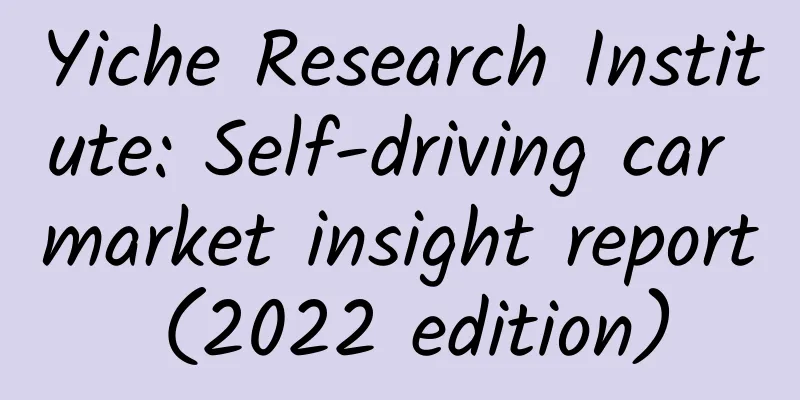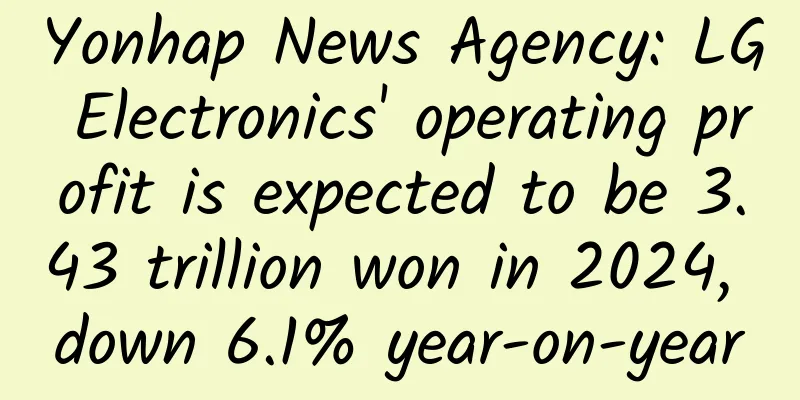Yiche Research Institute: Self-driving car market insight report (2022 edition)

|
Definition of the self-driving car market: a market segment dominated by the demand for self-driving car purchases At present, there are many classification standards for China's segmented auto market, some by level, some by category, and some by price; This report divides the car market into sub-markets based on car purchasing demands, such as the self-driving car market dominated by self-driving travel, the commuting car market dominated by commuting, and the business car market dominated by business... This report focuses on the "self-driving car market"; At present, scenario research has become a core research topic for most automobile companies. Car purchasing demands are closely related to scenario research. Reconstructing classification standards from the perspective of car purchasing demands will help automobile companies better carry out scenario research and, based on this, better optimize product layout and strategic adjustments. Self-driving travel market characteristics: From 2021 to 2025, China's self-driving travel will still be characterized by large cities, families, short distances, short time, and surrounding tours. Due to China's special national conditions such as few holidays and mainly short holidays, uneven regional development, strong family values, and purchase and traffic restrictions in large cities, Chinese self-driving tourists mainly come from relatively developed first- and second-tier cities such as Beijing, Shanghai, Guangzhou, Shenzhen, Chengdu, Chongqing, and Hangzhou. They are mainly family users, with parent-child travel as the main form and surrounding travel as the main feature. Most of the trips are within 50 kilometers, and a round trip does not use up a tank of gas. Most trips only last half a day, and they almost leave early and return late... Pure electric is a bit unsafe, and hybrid is just right; The Chinese self-driving travel market, which is dominated by characteristics such as big cities, families, short distances, short time, and nearby tours, will naturally spawn a self-driving car market with Chinese characteristics. The demand for self-driving travel has rebounded strongly, and the proportion of willingness has risen to 33.03% in 2022, approaching the core commuting, and has become the new core car purchasing factor for Chinese users. From 2018 to 2022, Chinese users' demand for self-driving car purchases fluctuated upward. In early 2020, the COVID-19 pandemic suddenly broke out, severely hindering self-driving travel and significantly reducing the corresponding car purchase demand. However, as China quickly achieved effective results in epidemic control, the demand for self-driving car purchases rebounded strongly, rising to 33.03% in 2022, which was comparable to the original core demand for commuting. During this period, the demand for commuting car purchases fluctuated downward; There are significant differences in product characteristics between products that mainly meet the needs of self-driving tours and those that mainly meet the needs of commuting. From 2022 to 2025, if the purchasing demands of users for self-driving tours and commuting continue to increase, it will pose severe challenges to the traditional family car concept of car companies that mainly meets the needs of commuting, and the product layout and strategic planning derived from this concept. The external consumption environment is gradually improving, and the internal product supply is quickly following up, which jointly promotes the strong rebound of China's self-driving travel demand for car purchases. In 2020-2021, although Chinese society suffered an unprecedented blow from the COVID-19 pandemic, which caused a severe impact on the Chinese auto market, the demand for self-driving cars rebounded rapidly and strongly, which was closely related to changes in internal and external factors: the urbanization rate, the number of retirees, the number of single people, the number of people in higher education, kilometers of construction mileage, urban rail mileage, income level and other aspects continued to improve, which jointly optimized the external consumption environment of the self-driving car market; SUV models became the focus of auto companies, hard-core models increased rapidly, auto companies accelerated the layout of the mid-to-high-end car market, and pickup trucks accelerated passengerization, etc., which jointly optimized the internal supply conditions of the self-driving car market; In the next few years, it is basically predicted that the above-mentioned internal and external factors will continue to evolve in a direction that is conducive to the development of the self-driving car market, and the strategic opportunity for major car companies to actively deploy in the self-driving car market will become increasingly mature. The overall self-driving car market in China shows the characteristic of "the older the age, the stronger the demand". In the future, the sales contribution of middle-aged and elderly people will continue to increase, which will help the development of the self-driving car market. According to the survey data of Yiche Research Institute, the overall Chinese self-driving travel market shows that the older the age, the stronger the demand for self-driving travel, but there are stage differences: the demand for self-driving travel of young users under 35 years old increases with age; the demand for self-driving travel of middle-aged users aged 35-54 shows a trend of first decreasing and then increasing. The demand for self-driving travel of 35-39 years old is reduced when they are busy with childbirth and childcare. After the age of 40, the children go to school and become sensible, and they can go out for outings on weekends, and the demand for self-driving travel continues to increase; after the age of 55, they gradually enter the retirement stage, and the demand for self-driving travel increases explosively; From 2022 to 2025, sales to China's auto market by middle-aged users aged 35-54 will further increase, continuously consolidating their dominant position. Sales contribution by elderly users aged 55 and above will also continue to increase. Coupled with the gradual increase in self-driving travel demands among middle-aged users and the explosive increase in elderly users, it basically means that China's self-driving travel auto market will continue to grow, and even explode. The overall self-driving car market in China shows the characteristics of "the higher the family wealth, the stronger the demand". In the future, the sales contribution of the middle class will continue to increase, which will help the development of the self-driving car market. Yiche Research Institute survey data shows that the higher the annual income of Chinese families, the stronger the users' demand for self-driving cars. In 2022, the demand for self-driving cars for working families with an annual income of less than 150,000 yuan was only 29.58%, while the middle-class and wealthy families were higher than the industry level, at 36.05% and 37.50% respectively. In 2021, China's auto sales are still highly concentrated in the working class, accounting for more than 60%. In the future, as policies such as common prosperity and building a middle-class society are implemented, the middle-class and wealthy car markets will continue to grow. In addition, the middle class and the wealthy have higher demands for self-driving tours, which will continue to promote the development of the self-driving tour car market. The overall self-driving car market in China shows the characteristic of "the higher the city level, the stronger the demand". In the future, the sales contribution of large cities will continue to increase, which will help the development of the self-driving car market. Yiche Research Institute survey data shows that the higher the level of Chinese cities, the stronger the users' demand for self-driving car purchases. In 2022, the demand for self-driving car purchases in second-tier, new first-tier, and first-tier cities was higher than the industry level, at 33.09%, 35.98%, and 39.70%, respectively. Users in first-tier cities such as Beijing, Shanghai, Guangzhou, and Shenzhen have a strong demand for self-driving travel; From 2017 to 2021, the contribution of second-tier, new first-tier and first-tier cities to the terminal sales of China's auto market continued to increase, from 52.03% to 56.78%. From 2022 to 2025, as young users continue to concentrate in large cities and core urban areas, the contribution of second-tier, new first-tier and first-tier cities to terminal sales is expected to exceed 60%. In addition, users in large cities have a stronger demand for self-driving car purchases, which will continue to promote the development of the self-driving car market. The overall Chinese self-driving car market shows the characteristics of "the more functions a car has, the stronger the demand". In the future, pickup trucks will accelerate the commercial-passenger transition and MPVs will accelerate the household application, so as to better compete in the self-driving car market. Due to its huge sales volume and good passability, SUVs are easily considered more suitable for self-driving tours. However, a survey by Yiche Research Institute found that MPVs lead the self-driving tour demands of potential users in the category, followed by pickup trucks. In 2022, the potential user demands for the two were 42.86% and 42.07%, respectively, both higher than SUVs. Compared with SUVs, MPVs have more prominent spatial advantages. In addition, Chinese self-driving tours are mainly around large cities, which can better accommodate the passability of MPVs. Compared with SUVs, pickup trucks have more prominent cargo functions and can better transport items needed for camping, picnics, barbecues, etc., and the passengerization of pickup trucks can also provide a better driving experience; Although the sales of MPVs and pickup trucks are relatively low, both below 1 million units in 2021, their internal structures have evolved dramatically, with MPVs accelerating their home use and pickup trucks accelerating their commercial to passenger use. From 2022 to 2025, the above two major evolution trends will be more significant, helping pickup trucks and MPVs better compete in the self-driving car market. China's self-driving car market shows the characteristic of "the higher the mainstream level, the stronger the demand". In the future, the sales contribution of mainstream high-level cars will continue to increase, and they will better compete in the self-driving car market. Yiche Research Institute survey data shows that the higher the level of the three major mainstream car markets, compact, medium and large, the stronger the user's demand for self-driving travel. In 2022, the demand for self-driving travel for medium and large SUVs reached 50.94%, ranking first, followed by medium and large MPVs, medium SUVs, medium MPVs, etc. From 2017 to 2021, the sales center of China's auto market continued to move upward, and the proportion of compact and lower levels continued to decline and fell below 70%. Mainstream high-level segments such as medium and large SUVs, medium and large MPVs, medium SUVs, and medium MPVs have all ushered in new long-term growth. From 2022 to 2025, the phenomenon of increased replacement purchases and consumption upgrades in China's auto market will continue to be significant, and the consumption center of China's auto market will further shift to the mainstream high-level segmented auto market. In addition, the mainstream high-level segmented auto market has a stronger demand for self-driving tours, which can better compete in the self-driving tour auto market. China's self-driving car market shows a "stronger demand for hybrid models" feature. In the future, the sales contribution of hybrid cars will grow explosively, and they will better compete in the self-driving car market. Yiche Research Institute survey data shows that the three major hybrid power users have strong demands for self-driving tours, namely, oil-hybrid, plug-in, and extended-range, at 37.27%, 41.29%, and 40.48% respectively, all higher than the market level. This is closely related to the relatively outstanding energy-saving performance of hybrid models and a wider range of usage scenarios. The demand for pure electric vehicles is relatively low, which is closely related to the short range and focus on urban scenarios. From 2017 to 2021, the sales of traditional fuel vehicles in China are still dominated by hybrid vehicles, and the hybrid vehicle market is in an active cultivation period. From 2022 to 2025, hybrid vehicles will become the new focus of automakers, and sales are likely to experience explosive growth. In addition, hybrid users have stronger demands for self-driving tours, which will better compete in the self-driving tour car market. The self-driving car market with Chinese characteristics has further nurtured the self-driving car purchase demands with Chinese characteristics - "four highs, one mixed, and one more" China's population structure, family income, consumer awareness, infrastructure, etc. are all undergoing drastic changes, giving rise to self-driving car purchase demands with Chinese characteristics - "four highs and one hybrid": the higher the age, the stronger the demand; the higher the family wealth, the stronger the demand; the higher the city level, the stronger the demand; the higher the mainstream level, the stronger the demand; the users who intend to use hybrid and multi-functional models have stronger demands; From 2022 to 2025, "four highs, one mixed, and one more" will become a yardstick for car companies to layout the self-driving car market. From 2022 to 2025, the soil for the development of China's self-driving car market will be more fertile. Yiche Research Institute predicts that the demand for self-driving car purchases will reach 45%, becoming the "first demand" in the Chinese car market. From 2022 to 2025, the soil for the development of China's self-driving travel market will be more fertile: the urbanization rate will be close to 70%, and the desire to travel will only be stronger; the number of retired people may exceed 150 million, breeding more demand for self-driving travel; the proportion of college graduates in the same age group will be close to 70%, which will not only further increase the urbanization rate, but also aggravate the phenomenon of singles, postpone the age of marriage, and further cultivate consumption awareness such as self-driving travel; the national residents' disposable income may exceed 40,000 yuan, laying a more solid foundation for self-driving travel consumption... From 2022 to 2025, based on the above-mentioned driving factors, China's demand for self-driving car purchases will continue to increase: the sales contribution of the middle-aged and elderly who prefer self-driving tours is expected to rise to 56% and 11%; the contribution of the middle class who prefer self-driving tours is expected to rise to 50%; the contribution of large cities who prefer self-driving tours is expected to reach 65%... Yiche Research Institute predicts that the demand for self-driving car purchases will reach 45%, becoming the "first demand" in China's auto market. In 2022, Ideal Auto leads the mainstream brand self-driving travel car purchase demand ranking In 2021, Ideal Auto's terminal sales volume was close to 100,000 units, based on the Ideal ONE alone. During the third round of the automobile industry tour exchange of Yiche Research Institute (December 2021 to January 2022), many car companies discussed the rapid rise of Ideal sales with Yiche Research Institute, and partly attributed the reason to "extended range", because most car companies are keen on pure electric vehicles, but it has a special liking for "extended range"; The "China Auto Market Self-Driving Tour Insight Report" helps to further explore the above issues. At the beginning of 2022, Yiche Research Institute's survey data showed that Ideal Auto topped the list of Chinese users' self-driving tour car purchase demands with a high score of 63.73%, and was significantly ahead of Land Rover, Mitsubishi, Tank, etc. that followed. Combined with background information such as "China's self-driving tours present characteristics such as big cities, families, surrounding areas, short distances, and short times, and Ideal ONE's main selling points of six seats, extended range, and families", the discussion about the rapid increase in Ideal sales may suddenly become clear; The top 10 brands for self-driving travel are mainly Chinese brands; in the top 20, luxury brands and mainstream brands are relatively far behind; electric car brands such as Tesla, Xiaopeng, and Weilai are not in the top 20; The leading brands have some common characteristics: they focus on medium and large SUVs, medium-sized SUVs, medium and large MPVs, medium-sized MPVs and other models; they highlight the hard-core or tough style; the market positioning is more segmented, the product layout is more focused, and the brand image is more distinct. In 2022, Ideal Auto leads the ranking of mainstream Chinese brands for self-driving travel car purchases In the Chinese brand camp, in addition to Ideal Auto, Tank and Maxus also have a relatively high demand for self-driving travel, with a proportion of more than 50%. From 2022 to 2025, as the demand for self-driving travel becomes the "first demand" in the Chinese auto market, it means that these three brands are more likely to become "dark horses". During this period, Ideal Auto, which is not afraid of wearing shoes, will undoubtedly go all out. Tank has become a hot commodity for Great Wall and is believed to get more resources. Maxus has a good "position" and must not fall behind. It needs more care from SAIC. In terms of independent resource investment, it must at least be on par with Roewe and MG. From 2022 to 2025, the high-end strategies of Weipai, Trumpchi, Lynk & Co, Xingtu, etc. will be optimized, and they can focus on mid-sized SUVs, mid-to-large SUVs, mid-to-large MPVs and other vehicles that are more suitable for self-driving tours; 2022 is BYD's ( 229.100 , 5.51 , 2.46% ) "crazy year" for new car launches. It is recommended that new cars such as high-end MPV DMI and mid-to-high-end SUV DMI should appropriately take into account the self-driving car market and strive to reduce internal friction; At present, the success of Haval Big Dog has allowed Haval to taste the sweetness of self-driving tourism. During the 14th Five-Year Plan period, self-driving tourism can be upgraded to an important breakthrough, with a focus on the layout of medium-sized SUVs and medium-to-large SUVs. During the 14th Five-Year Plan period, which one will dominate China's self-driving car market, Ideal or Tank? During the 14th Five-Year Plan period (2021-2025), self-driving tours will become the "first car purchase demand" in the Chinese auto market. Ideal and Tank are two brands with great potential to compete for the leadership of the self-driving tour car market; Ideal Auto has ideas for the 14th Five-Year Plan, with a sales target of 1.6-2 million vehicles. After terminal sales approached 100,000 vehicles in 2021, Ideal Auto announced in early 2022 that its full-size SUV would be named L9, and then news of the medium-to-large SUV L7 leaked online. Based on the L system, we naturally think there may be L5 or even L3, and Ideal ONE may be renamed L8 or L6 in the future. Regardless of the layout, during the 14th Five-Year Plan, Ideal Auto will also focus on the extended-range, home and high-level car markets, and will continue to consolidate its "base" centered on self-driving travel; In 2021, the Tank was born. The Tank 300 was powerful and unstoppable. In early 2022, the Tank 500 received continuous orders. In 2022-2023, there will be not only hybrid versions of the Tank 300 and Tank 500, but also new cars such as the Tank 400 and Tank 700. If the Tank can be lowered and have some "reduced configuration" city versions to better meet the "experiential self-driving tour" with Chinese characteristics, it will greatly enhance the competitiveness of the Tank brand in the Chinese self-driving tour car market. It is possible that the monthly sales of the Tank 300 will increase from 10,000 to 40,000 or 50,000. No matter whether Tank or Ideal dominates the self-driving car market, it will have an impact on the "third party" who are watching the fun. In 2022, Mitsubishi leads the ranking of mainstream overseas ordinary brands for self-driving travel car purchases At present, Mitsubishi and Jeep's sales in China are relatively bleak, but both are at the forefront of the demand for self-driving tours among ordinary overseas brands. From 2022 to 2025, as the demand for self-driving tours continues to increase, in theory, Mitsubishi and Jeep will have better opportunities, and the adjustment efficiency of joint venture automakers GAC Mitsubishi and GAC Fiat Chrysler will be tested in the future; The Explorer, which is more suitable for self-driving tours, has helped Ford to basically stabilize its position in China. Ford seems to have found a way, and more and more new cars are attached with the concept of self-driving tours; As the demand for self-driving cars continues to increase, Toyota Prado and Land Cruiser will continue to be produced in China, and they may even be considered to be launched at the same time in Yifeng and Guangfeng. The opportunities for self-driving travel will help Volkswagen further optimize its SUV strategy and create better space for sales of Touron, Langjing and other models. It is recommended that Jeep and Mitsubishi actively return to the origin and focus on the self-driving car market The mainstream brands initially defined in this report were based on terminal sales of more than 50,000 units in 2021, but I didn't see Jeep in the proofreading, which made me feel disappointed. Without Jeep, the self-driving brand list would be much less attractive. I was forced to lower the standard to 40,000 units, and only then did Jeep appear; Instead of dwelling on why Jeep's sales in China have been declining for four or five consecutive years, it is better to think about how to seize the new opportunities of self-driving tours, which was originally Jeep's "backyard"; Mitsubishi is also facing a similar situation to Jeep in China. First, its sales have dropped sharply, and second, it has a new opportunity to enter the self-driving car market; From 2022 to 2025, self-driving tours will become the "number one car purchasing demand" in the Chinese auto market. It is recommended that Jeep and Mitsubishi actively return to the starting point and fully switch to the self-driving tour market. In 2022, Land Rover leads the ranking of mainstream overseas high-end brands for self-driving travel car purchases Although Land Rover leads the list of overseas high-end brands for self-driving tours, it is a bit unfair. There is still a lot of room for improvement, especially in the mainstream self-driving tour car market of 300,000 to 400,000 yuan, where it is urgent to cultivate several models that can stand out. Second-tier overseas high-end brands such as Cadillac, Lincoln, and Volvo are all popular in the self-driving car market; In 2022, the localization of the medium-to-large SUV BMW X5L will help BMW better compete in the self-driving car market, open up new growth points, and better consolidate its leading position in the Chinese high-end car market; The self-driving car market is an obvious shortcoming of the pure electric brand Tesla. During the 14th Five-Year Plan period, the self-driving car market will become a new breakthrough for second-tier high-end brands During the 14th Five-Year Plan period, where will the second-tier overseas high-end brands go? As of the beginning of 2022, although the market performance of second-tier high-end brands such as Cadillac, Lincoln, Lexus, and Land Rover varies, they are still in an awkward position at the strategic level. They are under pressure from first-tier high-end brands such as Audi, Mercedes-Benz, and BMW, and are chased by pure electric high-end brands such as Tesla, Ideal, and Weilai. Their own brand building and new energy layout have not stood out; In the past two years, Cadillac and Lincoln have launched a new round of new car offensives, strengthening the SUV market, highlighting the price advantage, better catering to the new middle class, and have achieved certain results; From 2022 to 2025, as the middle class continues to grow, the urbanization rate continues to increase, and the demand for self-driving tours in the Chinese auto market continues to increase, self-driving tours have reason to become a new breakthrough for second-tier high-end brands. |
<<: DingDong speakers tell you: "Intelligence" and "Quality" should not be contradictory
>>: Can customization help home appliance companies break out of the cold winter?
Recommend
Is the price of Zhejiang hosting server cost-effective?
Is the price of Zhejiang hosting server cost-effe...
If you are positive for COVID-19 and do a CT scan, will the radiation be high? What should you pay attention to?
CT scan is an important means to determine the se...
What kind of tigers are in movies and TV shows? Tigger deceived me for 20 years
As the Year of the Tiger arrives, many classic im...
Lezi's "Practical Course on Making Money with Tik Tok Short Videos"
A practical course on making money with short vid...
Should I extract teeth to correct my teeth?
Many people who are planning to have their teeth ...
How much does it cost for Dehong to join a lottery app?
What is the price for joining the Dehong Lottery ...
EU launches investigation into suspected monopoly of Qualcomm's acquisition of NXP Semiconductors
According to foreign media reports, the EU antitr...
How to use the video account? Popular tips on the video account
If we talk about the short video platform that wa...
Master these 4 creative optimization techniques for information flow ads to increase click-through rate by over 30%!
Nowadays, information flow advertising has become...
How to write a hit short video title
Recently, many friends in the short video industr...
When it comes to regeneration, humans are really too weak...
In superhero movies, regeneration is a powerful s...
K12 online education user stratification operation strategy!
In user operations , more and more products have ...
A large collection of short video emotional copywriting resources, with tens of thousands of emotional copywritings of various types, so that you no longer have to worry about copywriting
A large collection of short video emotional copyw...
How will China's robotics industry take the lead in the battle for discourse power under the market size of 600 billion yuan?
Artificial intelligence and the robotics industry ...
Xiamen SEO Training: What is the trend of SEO optimization? What is the premise for stable ranking?
When doing SEO optimization, you need to constant...









